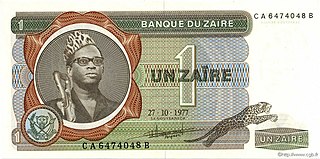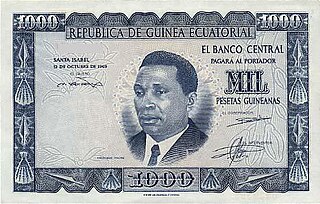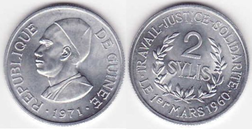
The lek is the currency of Albania. Historically, it was subdivided into 100 qintars.

The ariary is the currency of Madagascar. It is notionally subdivided into 5 iraimbilanja and is one of only two non-decimal currencies currently circulating. The names ariary and iraimbilanja derive from the pre-colonial currency, with ariary being the name for a silver dollar. Iraimbilanja means literally "one iron weight" and was the name of an old coin worth 1⁄5 of an ariary. However, as of May 2023, the unit is effectively obsolete since the iraimbilanja has practically no purchasing power, and the coins have fallen into disuse.

The dinar is the national currency of Tunisia. It is subdivided into 1000 milim or millimes (ملّيم). The abbreviation DT is often used in Tunisia, although writing "dinar" after the amount is also acceptable ; the abbreviation TD is also mentioned in a few places, but is less frequently used, given the common use of the French language in Tunisia, and the French derivation of DT.

The franc was the currency of Madagascar until 1 January 2005. It was subdivided into 100 centimes. In Malagasy the corresponding term for the franc is iraimbilanja, and five Malagasy francs is called ariary.

The Belgian franc was the currency of the Kingdom of Belgium from 1832 until 2002 when the euro was introduced. It was subdivided into 100 subunits, each known as a centiem in Dutch, or centime in French and German.
The Luxembourg franc (F or ISO LUF, Luxembourgish: Frang), subdivided into 100 centimes, was the currency of Luxembourg between 1854 and 2002, except from 1941 to 1944. From 1944 to 2002, its value was equal to that of the Belgian franc. The franc remained in circulation until 2002, when it was replaced by the euro.

The Guinean franc is the currency of Guinea. It is subdivided into one hundred centimes, but no centime denominations were ever issued.

The Djiboutian franc is the currency of Djibouti. Its ISO 4217 currency code is DJF. Historically, it was subdivided into 100 centimes.

The zaire was the unit of currency of the Democratic Republic of the Congo and then of the Republic of Zaire from 1967 until 1997. All but six of the 79 series of banknotes issued bear the image of Mobutu Sese Seko. Two distinct currencies existed: zaire, and nouveau zaïre.

The Katangese franc, was the currency of the unrecognized State of Katanga between 1960 and 1963 during its brief period of independence from the Republic of the Congo. It replaced the Congolese franc at par and was consequently initially equal to the Belgian franc. This established an exchange rate of 50 francs = 1 U.S. dollar. Just before Katanga was re-annexed by Congo, the exchange rate had fallen to 195 francs = 1 U.S. dollar. The currency was replaced at par by the Congolese franc.
The ekwele or ekuele was the currency of Equatorial Guinea between 1975 and 1985. Although nominally divided into 100 céntimos, no subdivisions were issued. The name ekuele was used until 1979, whilst ekwele was used after. The renaming of the currency to "ekwele" from "peseta" was motivated largely by a sweeping Africanization program meant to rid the country of its colonial past by removing Spanish names and references from the public domain; the ekpele was a pre-colonial iron currency used by the Fang and Beti people.

The peseta was the currency of Equatorial Guinea from 1969 to 1975. It replaced the Spanish peseta at par shortly after gaining independence from Spain the prior year and was later replaced, again at par, by the ekwele.

The peso was the currency of Guinea-Bissau from 1975 to 1997 and was divided into 100 centavos. It replaced the escudo at par. In 1997, in an effort to stop high inflation, Guinea-Bissau adopted the CFA franc, using a conversion rate of 65 pesos to the franc.
The Malian franc was the independent currency of Mali between 1962 and 1984. Although technically subdivided into 100 centimes, no subdivisions were issued.

The franc was the currency of Algeria between 1848 and 1964. It was subdivided into 100 centimes.

The Central African CFA franc is the currency of six independent states in Central Africa: Cameroon, Central African Republic, Chad, Republic of the Congo, Equatorial Guinea and Gabon. These six countries had a combined population of 55.2 million in 2020, and a combined GDP of over US$100 billion.

The West African CFA franc is the currency used by eight independent states in West Africa which make up the West African Economic and Monetary Union: Benin, Burkina Faso, Côte d'Ivoire, Guinea-Bissau, Mali, Niger, Senegal and Togo. These eight countries had a combined population of 105.7 million people in 2014, and a combined GDP of US$128.6 billion as of 2018.
The Ruanda-Urundi franc was a currency issued for the Belgian mandate territory of Ruanda-Urundi in 1960–62 which continued to circulate within its successor states of Rwanda and Burundi until 1964. The currency replaced the Belgian Congo franc which had also circulated in Ruanda-Urundi from 1916 to 1960 when the Belgian Congo became independent, leaving Ruanda-Urundi as the sole Belgian colonial possession in Africa. With the independence of Rwanda and Burundi in 1962, the shared Ruanda-Urundi franc continued to circulate until 1964 when it was eventually replaced by two separate national currencies.
The franc is the currency of New Caledonia and Wallis and Futuna, part of the CFP franc since 1945 and issued by the Institut d'émission d'outre-mer (IEOM) in Paris. It is subdivided into 100 centimes, although centime denominations are no longer in circulation.
The franc is the currency of French Polynesia, part of the CFP franc since 1945 and issued by the Institut d'émission d'outre-mer (IEOM) in Paris. It is subdivided into 100 centimes, although centime denominations are no longer in circulation.














